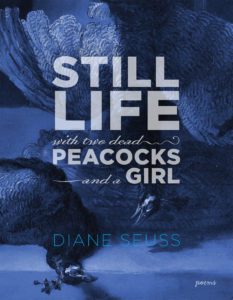
The expectation that Still Life with Two Dead Peacocks and a Girl by Diane Seuss is an ekphrastic collection is understandable given the title, but the poems in this book go beyond ekphrasis. With command of language, humor, and emotional intensity, Seuss’s work finds its home in art, philosophy, satire, and semantics, and suggests an informal salon where anything goes when considering art and aesthetics in a modern world.
The title poem ends in this pronouncement: “Art, useless as tits on a boar.” At the end of this sonnet of fourteen unrhymed sentences, this harsh review turns on itself a bit, as part of a poetic form created by Seuss in reference to “what Ginsberg called an American Sentence.” Each line of the sonnet is a complete sentence composed of seventeen syllables. Useless is the last thing art is in subsequent poems in the collection, written in response to visual art, music, Americana, and poetry, that solidify the need for art to function as historical documentation, emotional expression, and candid storytelling in dialogue with life and all of its messiness.
These poems are so full of meaning that to try to describe them feels futile, as if descriptions might defuse their glow and remove the reader’s potential to discover each piece for themselves. There are, however, significant aspects that are worth mentioning. “Self-Portrait with Double Helix” coils through memory making connections to past and present in remembrance of someone who sends the speaker on a search for meaning and dreaming of…
[…] a spiral staircase made of the white-blue stuff of stars,
the whole thing spinning at an even pace as if automated, not so much
a staircase as a coiled ladder, and on each rung a soul, miniscule, giving off
a dull glow like a lit cigarette far down the street during a power outage.
The vision of the soul being a dim light barely visible adds an intensity of sorrow also present in “Self-Portrait with My Dead Looming behind Me,” a poem that creates a multilayered metaphor for the people who have passed out of the speaker’s life: “They fan behind me like the tale of a strange bird, / or like a deck of cards in the hands of a fly-by-night / magician.” Each of these poems, one in loving couplets, the other in elegiac tercets, recalls real lives and recognizes that irony is often a necessary component of grief.
Black and white details of Rembrandt’s “Still Life with Peacocks” are scattered throughout the collection, keeping us moored to meaning in the colorless minute. Glimpses of peacock features—the feathers, heads, and shadows they cast—are tokens of what is and is not present in art and in our understanding of art. In these images, and in every piece in the collection, Seuss reminds us that so much depends upon noticing.
In one poem, the speaker dictates “At some point, you must // unpackage your pen.” And a few stanzas later utters the command to “[u]nmask syntax.” Seuss takes these directions seriously throughout the collection by challenging form and function while simultaneously inventing it. In a number of poems, each line is a sentence, perhaps bucking the conventions of caesura and line breaks. In others, punctuation is dispensed with, and lyrical narratives emerge in streams that appear in blocks, margins flush on each side of the page. Seuss uses vernacular to unveil what lies beneath language and metaphor, to scrape the underside of meaning. In “Hindenburg,” the realization that history has been forgotten is the horror behind the conversation described by the speaker:
the bug spray was small potatoes compared to
Nam and she’s like compared to what and I’m
like compared to Nam to Vietnam and she’s
like oh Vietnam he was over there for how long
In these lines, a slow forgetting casts a shadow of ignorance that breeds fear.
Fear and longing take their place in a number of pieces in the collection, none so much as the self-portraits with deceased poets and songwriters, among them Emily Dickinson, Sylvia Plath, and Freddie Mercury. These portraits act as elegies packed with images particular to each life story. “Self-Portrait with Emily Dickinson (Rebirth of Mourning)” considers loneliness in the midst of nature, death, and femininity. Images of “one pink cypripedium” and “vanilla heliotrope lugged through buttercups” evoke color and fragrance associated with death and cultivated life. The couplets in “Self-Portrait with Sylvia Plath’s Braid” create a different mood, defiant, invoking beauty and language as weapons to wield on the journey “through the world of men.” “Self-Portrait with Freddie M (Invention of Thunder)” is a surprising requiem, a tribute to the singer’s body, as it was his instrument that eventually failed him. The opening, “I was Freddie Mercury’s body,” suggests an intimate connection between the speaker and the grand personality whose “high note set off tornado sirens and wedding bells.” In each self-portrait, as well as in other poems in the collection, a fierce relationship between artist and audience is central to the story containing powerful emotions pulled taut between the two.
The terrible beauty of this collection is that it shows how necessary art is in helping us get through this life. Seuss’s examination of still life painting as engineered haphazardness employs the philosophy that life and art are the same, cannot be dispensed with, and that “art is not artifice it meets you where / you shrug off your robe or pile your strawberries in a basket with no eye for / composition.” The appearance of the haphazard is what artists and poets create. Seuss recalls Williams’ red wheelbarrow in its glistening randomness that’s anything but random, and takes it as evidence of “how nothing is casual nothing is uncomposed whether a curtain is drawn away / from the deathbedroom window or not.”
Gwendolyn Brooks said, “Poetry is life distilled.” Seuss has taken this further to include all art and language that exists for artists and poets to uncover in the murkiness of civilization. She has presented a world where we create our own mythologies, observe our relationship with art in all of its manifestations, and dare to “tear away the beautiful feathers.”
***
Photograph of Diane Seuss © Gabrielle Montesanti.





